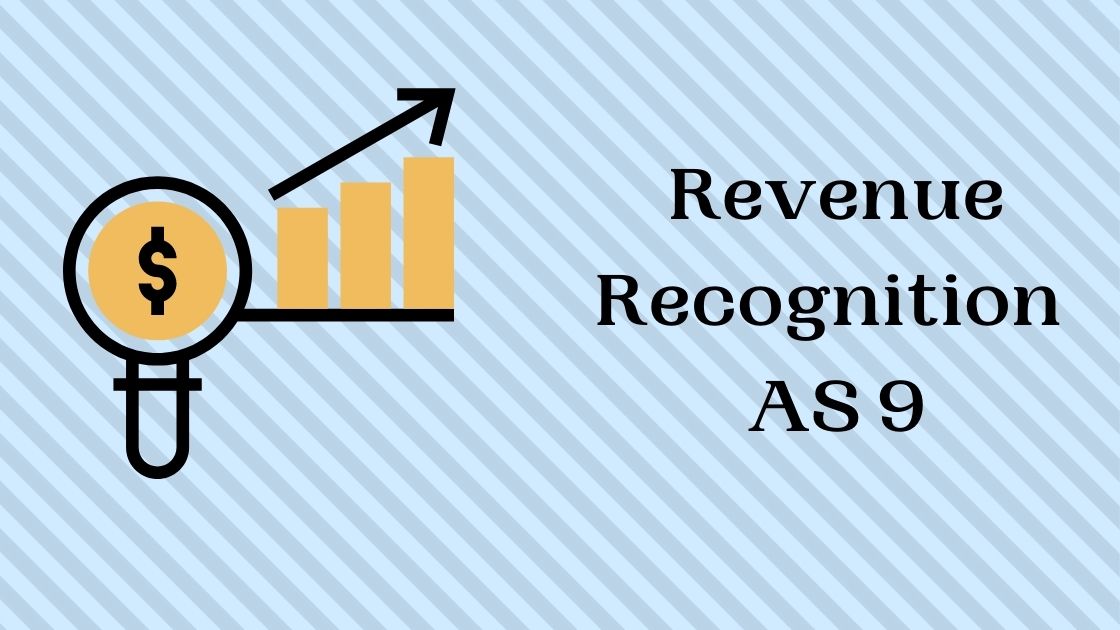Meaning of Revenue
Accounting standard 9 provides the basis on which an entity shall recognize the revenue in the statement of profit and loss. It covers the revenue arising from ordinary business activities.
As per AS 9, “revenue is the gross inflow of the considerations that arises in the course of ordinary activities of an enterprise. The consideration can be in the form of
- Cash,
- Receivables, or
- Any other considerations
And, such considerations arise from
- Sale of goods,
- Rendering of services and
- Other sources such as interest, dividend, or royalty.
Applicability of AS – 9 Revenue recognition
Inclusions: Revenue arises from the sale of goods or services.
Exclusions: Revenue arising from:
- Construction contracts
- Hire purchase, lease agreements
- Government grants and other similar subsidies
- Insurance contracts for the insurance companies
Scope of AS – 9 Revenue recognition
- Timing of recognition of revenue in the profit and loss account
- Amount of revenue arising as a result of the transaction
- Expenses incurred or associated costs against the revenue earned
- If any uncertainties arise in determining the amount or the related costs that may influence the timing of revenue recognition.
Revenue recognition from Sale of Goods
In the case of the sale of goods, the revenue recognition takes place when the two events occur:
- The seller has transferred the goods to the buyer for consideration, and
- The transfer of the significant risk and rewards of ownership
However, if the transfer of goods doesn’t coincide with the transfer of risk and rewards, the seller shall recognize the revenue when the significant risk and rewards of ownership is transferred. Such situation may arise due to:
- An agreement entered between the parties, or
- Delay in delivery of the goods,
Revenue recognition from Sale of services
As per AS – 9, revenue recognition of services primarily depends on the performance of services. It can be in two ways:
- Proportionate completion method
In this method of accounting, the revenue is recognized in the profit and loss statement proportionately. It depends upon the degree of completion of services under a contract. The revenue recognition shall be determined on the basis of:
- Contract value
- Associated costs
- Number of acts, or
- Any other suitable basis
However, if the services involves an indeterminate number of acts over a specific period of time, then a straight-line basis is preferable.
- Completed service contract method
This method of accounting recognizes revenue in the profit and loss statement only when the rendering of service is completed or substantially completed. Here, the services consist of the execution of a single act under the contract.
Interest, dividend and royalties
Interest: income earned for the use of amounts due to the entity.
Revenue recognition: Revenue from the interest is recognized on a time proportion basis after considering the applicable rate and outstanding amount.
Dividend: Rewards earned from holding an investment in shares.
Revenue recognition: Revenue from dividend is recognized when the owner’s get the right to receive the dividend.
Royalty: Income earned for the use of assets such as patents, know-how, copyrights, trademarks, etc.
Revenue recognition: Revenue from royalty is recognized on an accrual basis and according to the agreement entered between the parties.
Effect of uncertainties on revenue recognition
AS per AS – 9, revenue recognition requires two main parameters, i.e.,
- Revenue must be measurable
- It would be unreasonable to expect the revenue collection at the time of sale or the rendering of services
However, few cases can be dealt with as:
- If it is not possible to assess the final collection of revenue with reasonable certainty at the time of making a claim, such as a price hike, export incentives, etc. –recognize revenue only at the time of the final collection of revenue.
- If there is no uncertainty related to the final collection of revenue – recognize revenue at the time of sale or rendering of services (even in case of payments made in instalments).
- When there is uncertainty after the time of sale or rendering the services – create a separate provision containing the uncertainty. Hence, there is no need to adjust the amount of revenue originally recorded.
- If revenue recognition is postponed due to uncertainties – Revenue shall be considered for the period in which it is properly recognized.




